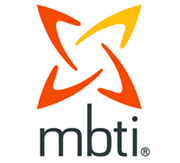Using MBTI® Type to Foster Individual Development
Using MBTI® Type to Foster Individual Development
Remember: While every type has its unique combination of assets, each is also subject to a downside due to potential overuse or rigidity. Continue to leverage your strengths and the strengths of others but seek opportunities to address developmental needs and grow professionally.
- To Extraverts: “Practice Introversion by counting to 10 when you’re feeling especially action-driven or enthusiastic, or reflecting on ideas and plans to fully consider them before acting.”
- To Introverts: “Practice Extraversion by soliciting input from others and seeking assistance with formulating plans, even if you prefer to approach the task independently.”
- To Sensing types: “Practice Intuition by creating a one- to two-page executive summary describing the trends or patterns suggested by the data under consideration.”
- To Intuitive types: “Practice Sensing by using precise, accurate details in a report or project that you don’t believe merits such information.”
- To Thinking types: “Practice Feeling by moving outside your normal range of conversational topics to share some personal facts, details, or insights about yourself.”
- To Feeling types: “Practice Thinking by purposely giving simple, direct, and concise feedback to others.”
- To Judging types: “Practice Perceiving by scheduling one day a month at work to “go with the flow” and noting any value that such flexibility brings.”
- To Perceiving types: “Practice Judging by determining what daily tasks you could do consistently and then developing a routine and sticking to it.”
-
- What behaviors would you like to start, and how might you begin making small steps toward making the requisite changes?
- How might you track your progress to determine what new behaviors or approaches are making a positive impact? Now, consider your own type preferences and how they relate to the way you approach your daily tasks and progress toward your professional goals.
Source: Adapted from Hirsh and Kise, Introduction to Type® and Coaching (1998), pp. 13–14, www.cpp.com
More From Michele
Tips For The D Style Interaction, The DiSC Personality Type Assessment
How the high "D" works with . . . High D: During stressful times and conflict the High "D" might: If there is mutual respect, see another High D as driving, visionary, aggressive, assertive, competitive, & optimistic If mutual respect does not exist, see...
The “C” Style DiSC Personality Type Assessment
Compliant - Correct - Cautious(Takes on Passive Roles & is Task-Oriented) General Characteristics:Accurate, analytical, conscientious, careful, fact-finder, precise, high standards, systematic Strengths: Accurate Planning Systems Orchestration Details Blind...
The “S” Style DiSC Personality Type Assessment
Stable - Steady - Supportive(Takes on Passive Roles & is People-Oriented) General Characteristics:Good listener, team player, possessive, steady, predictable, understanding, friendly Strengths: Great listener Teamwork, Team player Good follow-through Person...




